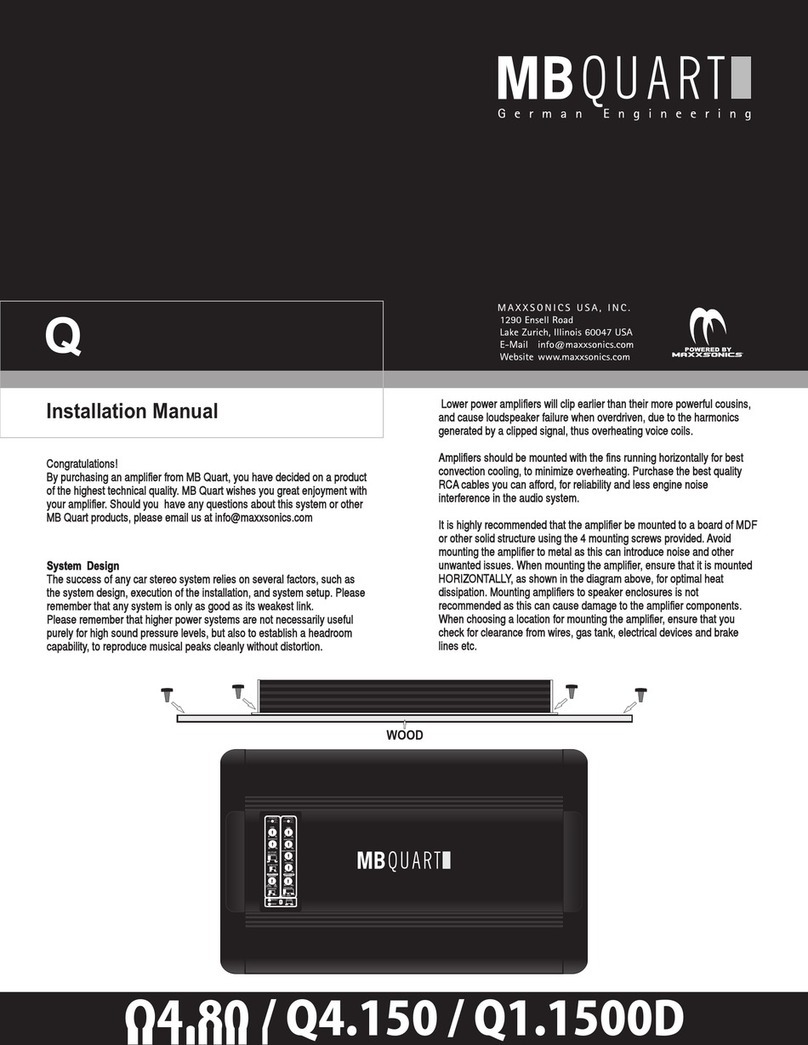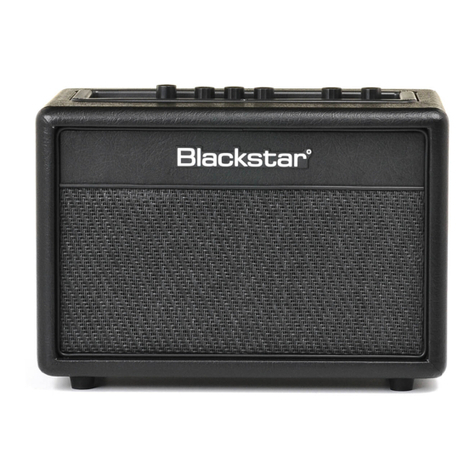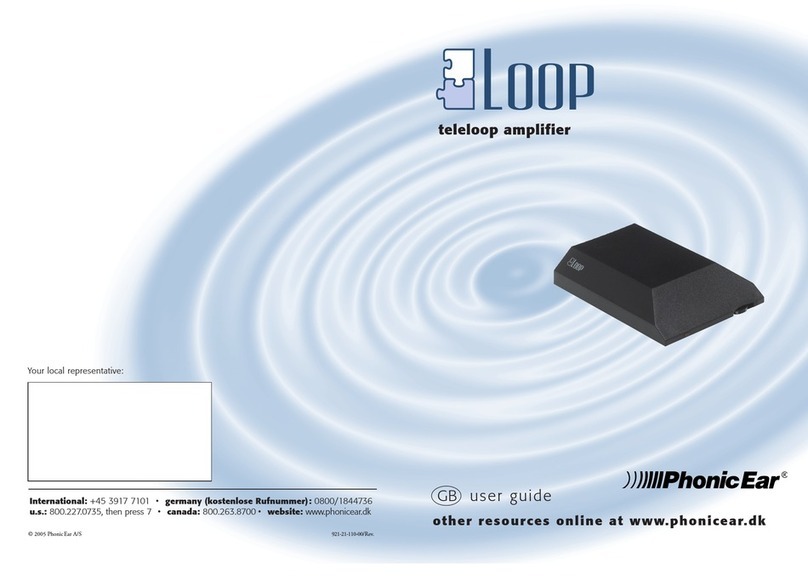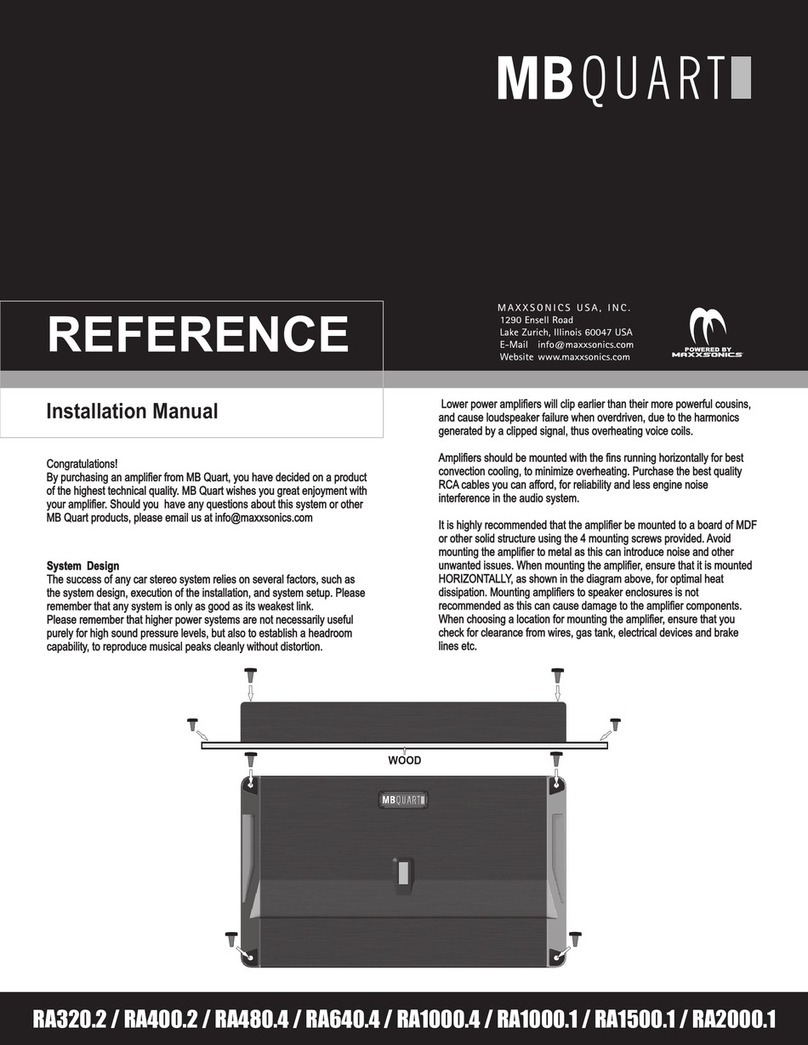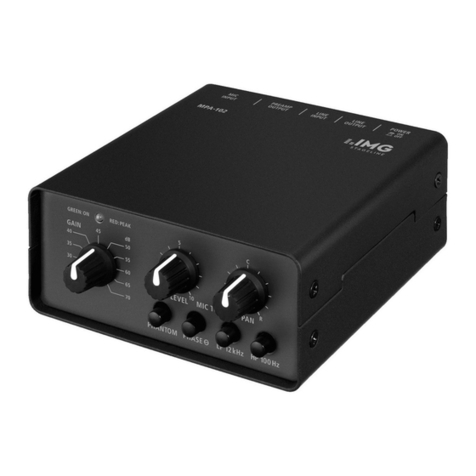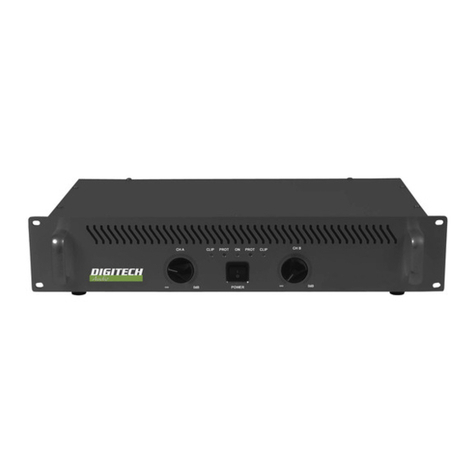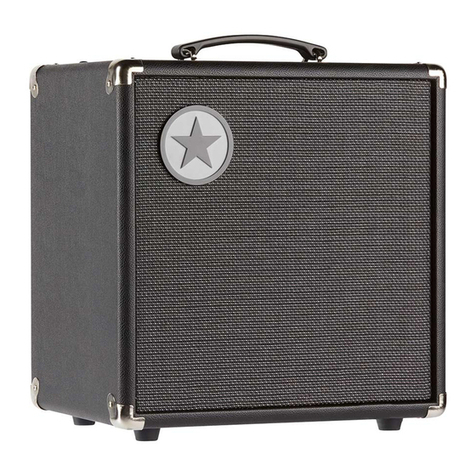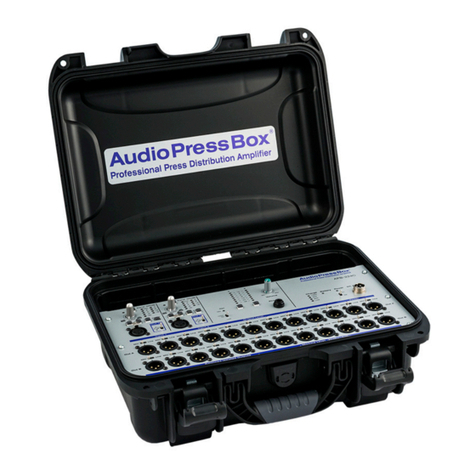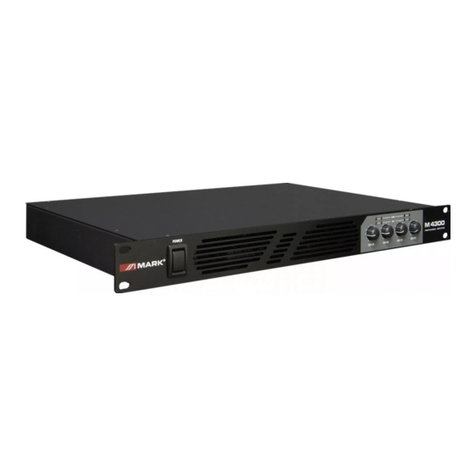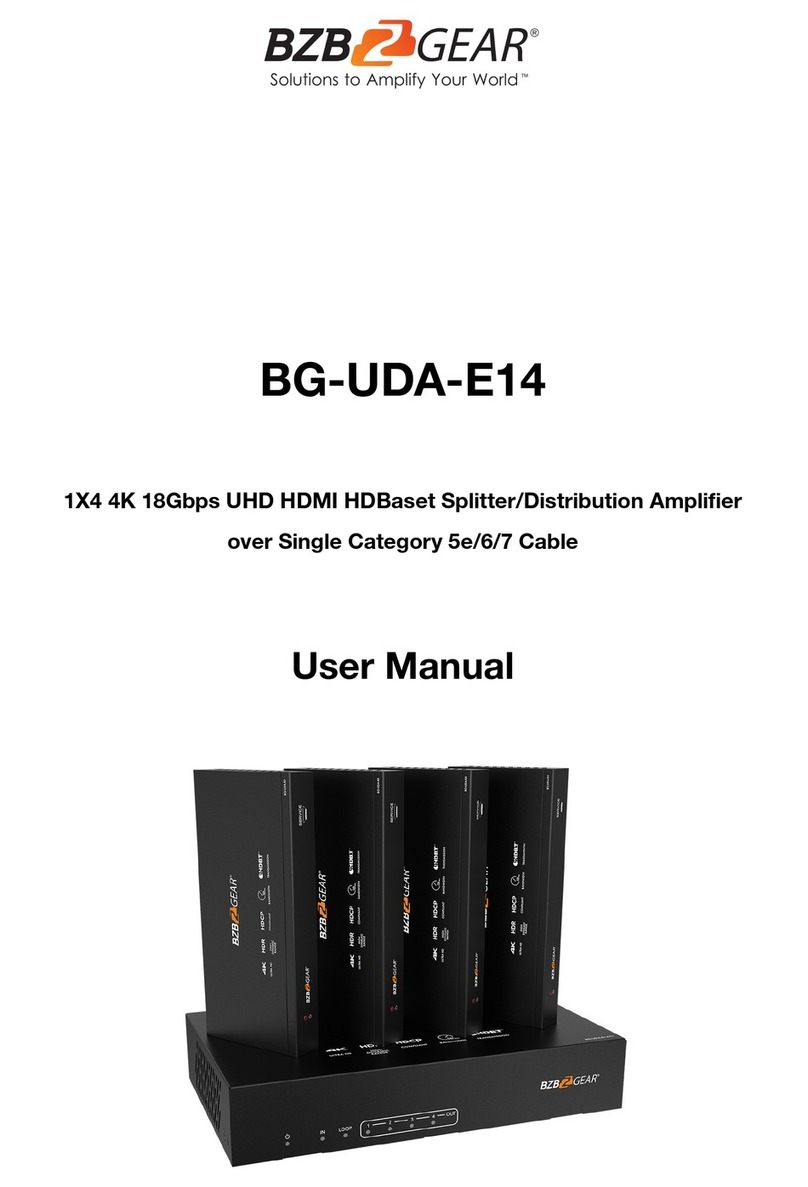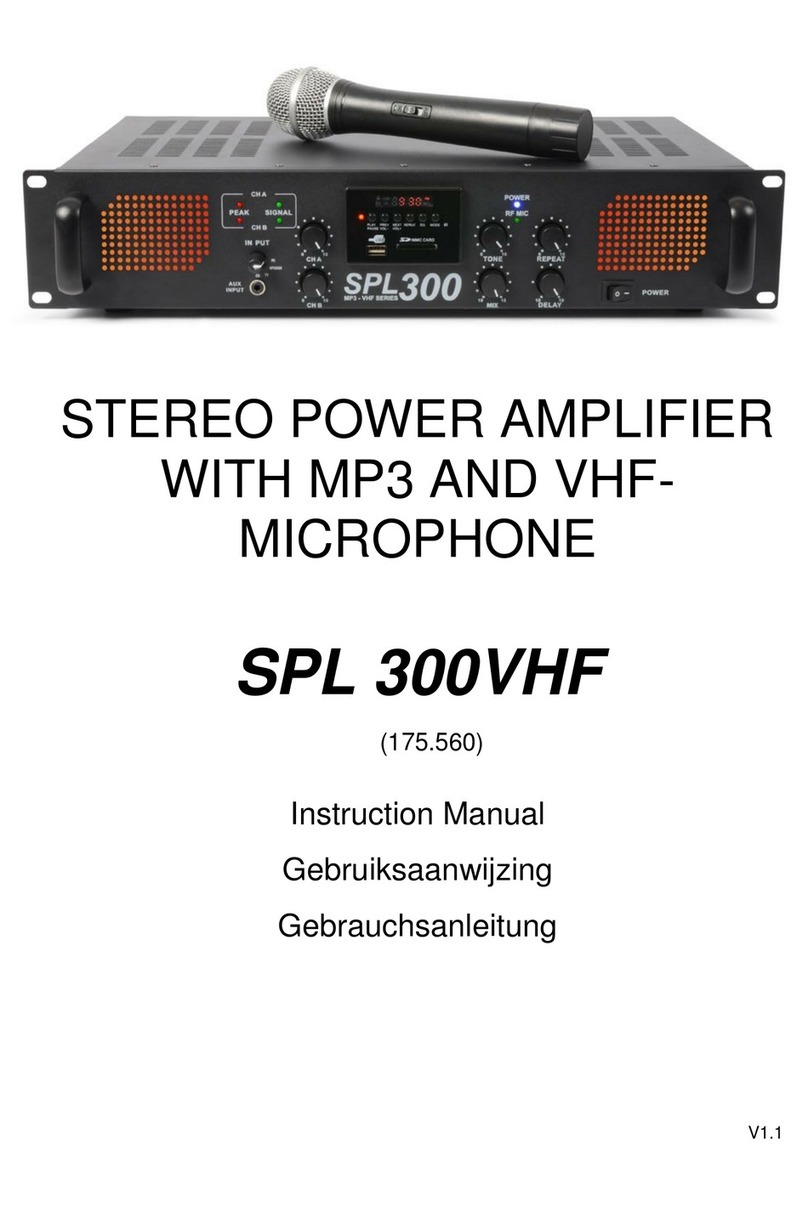Sound Devices MixPre-D Manual

MixPre-D
User Guide and Technical Information
Sound Devices, LLC
300 Wengel Drive • Reedsburg, WI • USA
+1 (608) 524-0625 • fax: +1 (608) 524-0655
Toll-Free: (800) 505-0625
www.sounddevices.com
suppor[email protected]


MixPre-D User Guide and Technical Information
1
Table of Contents..............................1
Front Panel Description . . . . . . . . . . . . . . . . . . . . . . . . 2
Side Panels Description . . . . . . . . . . . . . . . . . . . . . . . . 3
Inputs.......................................4
Mic / Line Setting ...................................4
Phantom Power ....................................4
Input Gain Control ..................................4
High-pass Filter ....................................5
Limiters. . . . . . . . . . . . . . . . . . . . . . . . . . . . . . . . . . . . . . . . . . . 5
Pan Switch ........................................5
Inputs 3 and 4 .....................................5
Input Linking.......................................6
X/YStereoLink................................... 6
MSStereoLinking ................................ 6
Outputs......................................6
XLR Outputs ......................................7
Tape Output .......................................7
AES Digital Output ..................................7
Sampling Rate .................................... 7
Monitoring...................................7
Headphone Gain ...................................7
Headphone Source Selection .........................8
Metering ..........................................8
Tone Oscillator & Slate Microphone . . . . . . . . . . . . . . 8
Slate Microphone ...................................8
Tone Oscillator .....................................8
Powering.....................................9
Power Switch and LED ..............................9
Internal Batteries ...................................9
External DC Sources ...............................9
ComputerInterface............................9
Installation and Connection with Mac OS ...............10
OS X Audio / MIDI Setup........................... 10
Adjusting Sample Rate in OS X...................... 10
Windows Installation and Connection ..................10
Windows Vista and Windows 7 Sound Control Panel . . . . . 10
Adjusting Sample Rate in Windows Vista and Windows 7 . 10
Windows XP Sound Control Panel . . . . . . . . . . . . . . . . . . . 10
Front Panel Button Shortcuts. . . . . . . . . . . . . . . . . . . 11
Specifications ...............................12
Warranty and Technical Support . . . . . . . . . . . . . . . . 14
CE Declaration of Conformity...................15
Table of Contents
Copyright and Release
All rights reserved. No part of this publication may be reproduced, stored in a retrieval system, or transmitted in any form or by any
means, electronic, mechanical, photocopying, recording, or otherwise, without the expressed written permission of SOUND DEVICES,
LLC. SOUND DEVICES is not responsible for any use of this information.
SOUND DEVICES, LLC shall not be liable to the purchaser of this product or third parties for damages, losses, costs, or expenses
incurred by purchaser or third parties as a result of: accident, misuse, or abuse of this product or unauthorized modifications, repairs, or
alterations to this product, or failure to strictly comply with SOUND DEVICES, LLC’s operating and installation instructions.
Microsoft Windows is a registered trademark of Microsoft Corporation. Macintosh is a registered trademark of Apple, Inc. Other product
and company names mentioned herein may be the trademarks of their respective owners.
The sound waves logo is a registered trademark of Sound Devices, LLC.

MixPre-D User Guide and Technical Information
2
v1.0 Features and specifications are subject to change. Visit www.sounddevices.com for the latest documentation.
Front Panel Description
213
1
6
7
3
4
58
9 10
11
12
Link LEDs1)
Indicates linked status of inputs. Both
LEDs off: no link; Bottom LED illu-
minated: stereo linking; Both LEDs
illuminated: MS stereo linking. See Input
Linking
Input Gain Controls2)
Potentiometers to adjust input gain.
Fully counter-clockwise is off.
High-Pass Filter LEDs3)
Indicates that the high-pass filter is
engaged for the input. One LED illumi-
nated: 80 Hz; Both LEDs illuminated:
160 Hz.
Input Buttons4)
Toggles between high-pass filter settings
for the input (Off / 80 Hz / 160 Hz).
Pan Switches (Input Assignment)5)
Three-position switch pans input to Left,
Center (both left and right) or Right
outputs. When inputs are linked, Input 2
Pan Switch function is altered. See Input
Linking
Tone Oscillator/Slate Microphone 6)
Switch
Toggle switch activates a 1 kHz tone
oscillator when switched to the left posi-
tion and activates the slate microphone
when in the right (momentary) position.
Microphone inputs are muted when
tone or slate are activated.
Limiter Switch7)
Activates both the input and output lim-
iters. Middle: (LIM) dual-mono limiter
operation; Right: (LINK) stereo opera-
tion. Threshold is adjustable. See Front
Panel Shortcuts
Headphone Connector8)
Accepts stereo and mono headphones
with 1/4-inch connectors.
Return Signal LED9)
Indicates presence of signal on RTN
input or Channel 3 & 4 input. See Inputs
3 and 4
Monitor Source LED10)
Indicates monitor source. Off: output
bus. Solid: Return signal or 3,4 Input en-
abled. See Inputs 3 and 4; Flashing: USB
output signal. See Computer Interface
Headphone Controller11)
Rotating controls headphone gain. Push
to cycle between monitor sources. Also
controls various secondary functions.
See Front Panel Shortcuts
Sample Rate LEDs12)
Indicates the current sample rate when
AES output is active or USB is con-
nected.
Power Switch and LED13)
Three position switch: Middle: off;
Left: (INT) internal power; Right: (EXT)
external power. Power illuminates green
for adequate voltage and flashes green
when voltage is low.

MixPre-D User Guide and Technical Information
3
Side Panels Description
11
42 7 7 10
9866
2 5
3
XLR Inputs1)
Transformer balanced input stage. Pin 1:
ground; Pin 2: ‘hot’ (+); Pin 3: ‘cold’ (-).
Can be unbalanced by grounding pin 3
to pin 1 of the XLR connector.
Mic/Line and Phantom Power Switch2)
Selects the input level of the adjacent
XLR input. Left: (48V) mic level with
phantom power; Middle: (MIC) mic
level without phantom power; Right:
(LINE) line level. Mic level has 40 dB
more gain than line level.
Stereo Mic-level Output3)
Unbalanced stereo signal on a TA3 con-
nector. Signal from this output is mic
level (-36 dBu). Pin 1: ground; Pin 2: left;
Pin 3: right.
Stereo Line-level Output (Tape Out)4)
Unbalanced, stereo, 3.5 mm output
connector. Signal from this output is
aux level (-10 dBu). Tip: left; Ring: right;
Sleeve: ground.
12V Phantom LED5)
Illuminated: phantom power is set to 12
V; Off: phantom power is set to 48 V.
XLR Outputs6)
Active-balanced outputs. Mic or Line
switchable. Right output can also be set
to AES. Pin 1: ground; Pin 2: ‘hot’ (+);
Pin 3: ‘cold’ (-).
XLR Output Switch7)
Sets level of output XLRs. Left: (MIC)
mic level (-40 dB); Middle: (LINE) line
level; Right: (AES) AES digital. The AES
setting is available on the right output
only. AES signal carries 2 channels on
one balanced connector.
USB Port8)
USB connector for interconnection with
the computer. USB 1.1 and 2.0 compli-
ant.
Return Input9)
Unbalanced, stereo, 3.5 mm input con-
nector. Feeds return signal to monitors
or 3,4 Inputs. See Inputs 3 and 4. Tip: left;
Ring: right; Sleeve: ground.
DC Input10)
Accepts input voltage from 10 to 17
V for mixer powering. Pin 1: negative
(-); Pin 4: positive (+). External DC is
isolated (floating) from the rest of the
circuitry.

MixPre-D User Guide and Technical Information
4
v1.0 Features and specifications are subject to change. Visit www.sounddevices.com for the latest documentation.
Inputs
The MixPre-D features two transformer balanced analog inputs. Each input provides enough gain
to amplify a variety of signals from low-sensitivity ribbon and dynamic microphones, medium-level
wireless and condenser microphones, and “hot” line level signals.
The XLR inputs of the MixPre-D are transformer-balanced. The isolation characteristics of transform-
ers are superior to other balancing techniques and are ideal for the hostile and uncontrolled environ-
ments of field production. Transformers provide galvanic isolation from the driving source, meaning
there is no direct electrical connection. Signals are “transformed” magnetically. The input transform-
ers in the MixPre-D use premium magnetic core material to achieve high signal handling capability
(especially at low frequencies) while keeping distortion to a minimum. Because of their inherently
high common mode impedance, transformers are unrivaled by any other type of input for common-
mode noise rejection.
The inputs of the MixPre-D can be used as balanced or unbalanced. When unbalancing, ground
pin-3 to pin-1 of the XLR connector. There is no change in gain between unbalanced and balanced
connections into the MixPre-D.
Mic / Line Setting
Before plugging a source into an XLR input on the MixPre-D, set the Mic/Line and phan-
tom powering switch to the correct position:
Setting Input Source
48V Condenser microphones requiring phantom power
MIC Dynamic microphones, some ribbon microphones, devices outputting mic-level signal (for example,
wireless receivers).
LINE Devices outputting line-level signal (outputs from other mixers, for example)
Phantom Power
Phantom powering is a fixed DC voltage at either 12 or 48 volts. This voltage is resistively applied
to pin-2 and pin-3 of an XLR connector relative to pin-1. There is no voltage difference between the
signal pins-2 and -3. Dynamic microphones will operate as normal when phantom power is applied
to them.
The MixPre-D can provide up to 10 mA to each input at 48 V, sufficient for the most power-hungry
condenser microphones. Many phantom powered microphones do not require 48 V and can be prop-
erly powered with 12 V. When acceptable, use 12 V phantom to extend the MixPre-D’s battery life.
The phantom voltage level can be set to either 12 V or 48 V and is applied across all inputs where
phantom power is selected.
To change the phantom voltage between 12 V and 48 V, hold down the Headphone Controller
and slide the Slate switch into the slate position. The 12 V Phantom LED on the left side panel
illuminates green when the phantom voltage is set to 12 V.
Input Gain Control
The amount of gain applied to an input is adjusted with the Input Gain Control. A fully
clockwise position results in no signal passing from the input to the output bus (muted).
Up to 66 dB of gain is available from for microphone inputs.

MixPre-D User Guide and Technical Information
5
High-pass Filter
Each input of the MixPre-D has a two-position high-pass filter. High-pass (or low-cut/low frequency
roll-off) filters are useful for removing excess low frequency energy in audio signals. Wind noise is a
common unwanted low frequency signal and a high-pass filter is effective for reducing wind noise.
For most audio applications engaging the high-pass filter is beneficial, since little usable audio infor-
mation exists below 80 Hz, especially for speech reproduction.
The MixPre-D’s high-pass filters feature a 6 dB/octave slope with either 80 Hz or 160 Hz corner (-3
dB) frequencies. The 160 Hz setting is used when aggressive filtering is required. The MixPre-D’s
high-pass circuit is unique because of its placement before any electronic amplification. Most mixer’s
high-pass circuits are placed after the mic preamp, where all of the high-energy low-frequency
signals get amplified. Because the MixPre-D’s circuit cuts low-frequency signals before amplifying,
higher headroom is achieved in presence of signals with a high amount of low-frequency energy.
When possible, attempt to equalize at the sound source with microphone selection, use of wind-
screens, microphone placement, and on-board microphone filtering. Many microphones have on-
board high pass filters, and the high-pass filters on the MixPre-D can be used in conjunction with the
microphone’s filters to increase the filter’s slope.
The three available high-pass filter settings are switched for each input by pressing the Input Button
for the adjacent input. The two blue High-pass Filter LEDs for each input indicate the setting of the
high-pass filter for the adjacent input.
Limiters
The MixPre-D Limiters act solely as “safety” limiters. Activate the Limiters using the front panel
“LIM” switch. Both input and output limiters are active, with input limiters preventing overload of
the input stage and output limiters preventing the MixPre-D from overloading the next device in the
signal chain.
In normal operation, with a properly set gain structure, the limiter threshold is only occasionally
reached. In the presence of extremely high input signal levels, such as in high SPL environments,
the limiter(s) activate to prevent the input signal from clipping. The limiters have no effect on audio
below the set threshold.
When Inputs 1 and 2 are linked as a stereo pair, the limiters also link; gain reduction is equal for both
inputs.
To change the threshold of the limiters, hold down both the Input 1 Button and the Input 2 Button
and turn the Headphone Controller.
Pan Switch
The pan switches assign inputs to the channels of the output bus. Inputs can be sent to the left,
right, or both outputs equally. The MixPre-D features excellent “off-attenuation” in the left and
right positions. With the use of the pan switches, separate mixes can be sent to the left and right out-
puts. For example, a summed mono mix of both inputs can be sent to the right output while a single
input can be sent to the left output.
Inputs 3 and 4
Each channel of the Tape Return input can be routed to various locations. When additional inputs
are needed (such as when multiple wireless receivers are used) the Tape Return channels can be
independently routed to the main output bus of the MixPre-D to act as additional inputs (3 and 4).

MixPre-D User Guide and Technical Information
6
v1.0 Features and specifications are subject to change. Visit www.sounddevices.com for the latest documentation.
To cycle between the available routings of the Tape Return signal, hold down the Input 1 Button (for
Channel 3) or the Input 2 Button (for Channel 4) and press the Headphone Controller. An LED in the
right meter will illuminate to represent the destination of the routing:
-30: RTN L (Channel 3) or RTN R (Channel 4)•
-18: Left output bus.•
-16: Center (left and right) output bus•
-14: Right output bus•
When any channel of the Tape Return input is routed to the main output bus, the Monitor Source
LED will remain illuminated to indicate this.
The TAPE RTN (Input 3 and 4) Input is an unbalanced stereo input that is suitable for tape or line level
devices only. There are no microphone preamps on Inputs 3 and 4.
Input Linking
Stereo linking allows Inputs 1 and 2 to be controlled as a single, stereo input. This is useful when
stereo microphones or stereo line level signals are used with the MixPre-D. There are two modes of
operation for stereo linking, X/Y link and MS stereo.
The Linked status of the inputs is indicated by the Link LEDs on the front panel. When both LEDs
are off, the inputs are not linked. To cycle between linking configurations hold down both Input 1
and Input 2 Buttons and slide the Slate Switch to the Slate position.
X/Y Stereo Link
When in X/Y stereo link operation, Input 2’s Pan Switch controls the stereo image (L: Input 1 = Left,
Input 2 = Right; C: Both Inputs in both channels; R: Input 1 = Right, Input 2 = Left). Channel 2’s
Fader controls the overall level of the stereo pair. Input 1 and 2’s High-pass Filters continue to act
independently of each other. When linked, Input 1 and 2’s Limiters are also linked.
MS Stereo Linking
When MS stereo linking is selected in the Setup Menu, Inputs 1 and 2 are linked as an MS (Mid-Side)
stereo pair. Connect the mid signal (unidirectional / cardioid microphone) to Input 1 and the side
signal (bi-directional microphone) to input 2.
Input 2’s Level Control adjusts the overall gain of the MS stereo pair. Input 1’s Level Control adjusts
the “spread”, or width of the stereo image. Input 2’s Pan Switch controls the polarity of the side
signal (L: Normal, R: Inverted). Reverse polarity to flip the stereo image between right and left. The
center (“C”) position of Input 2’s Pan Switch mutes the side signal; only the mid signal is present,
resulting in a mono signal. Input 1’s Pan Switch is disabled in MS linking mode. Input 1 and 2’s
High-pass Filters continue to act independently of each other.
Outputs
The MixPre-D is a two-output-bus mixer. Each input can be “hard panned” between the left and
right output bus making it easy to use the MixPre-D in either stereo or dual-mono operations. Be-
cause dialog is often recorded in mono, each output connector can be used to send signal to separate
cameras or recorders. The MixPre-D’s XLR Outputs, Tape Outputs, Stereo Unbalanced Mic Outputs,
and AES Digital Output share the same program content and pan assignment.
There is no master level control on the MixPre-D. The master is factory-set to unity gain, or “0” dB.

MixPre-D User Guide and Technical Information
7
XLR Outputs
The two XLR outputs are active-balanced connections, each capable of driving long lines. These
connections can be used as either balanced or unbalanced. When unbalancing, use pin-2 for (+) and
pin-1 for ground; float (leave open) pin-3.
Tape Output
The Tape Output is typically used to interface with consumer inputs such as Comtek inputs or con-
sumer transcription recorders. The MixPre-D has an unbalanced, two-channel tape level output on a
single, TRS 3.5 mm connector.
The Tape Output program is identical to the XLR Output. Tape Out level is fixed at a -10 dBu nomi-
nal level and is electrically isolated from the XLR Outputs. Additionally, the Tape Output is used for
the Mix Out signal to link multiple Sound Devices mixers. See Mixer Linking.
AES Digital Output
The Right XLR Output can be set to AES digital signal by sliding the XLR Output
switch to “AES”. In this configuration, the Right XLR Output contains both channels of
the MixPre-D’s output as a balanced, AES3 signal. All other outputs are unaffected, so inputs panned
left will appear on the left channel of the AES output plus the left channel of all analog outputs (in-
cluding the left XLR main output).
Sampling Rate
The MixPre-D’s digital system operates at sample rates of 44.1 kHz, 48 kHz, or 96 kHz. When either
a USB connection or AES output is enabled the operating sample rate of the MixPre-D is indicated
by the front panel Sample Rate LEDs. If AES output is disabled and there is no USB connection to a
computer both Sample Rate LEDs are off.
To change the sampling rate of the MixPre-D, hold down the Headphone Controller while sliding
the Right XLR Output switch to “AES”.
When connected to a computer with a USB cable, the sample rate of the MixPre-D is set by the comput-
er’s operating system and the sample rate cannot be changed from the MixPre-D. See Computer Interface
Stereo Unbalanced Mic Output
The Stereo Unbalanced Mic Output is designed to interface with “pro-sumer” DSLR-
type cameras. The MixPre-D has an unbalanced, two-channel “hot” mic level output
on a single, locking, TA3M connector.
The Stereo Unbalanced Mic Output program is identical to the XLR Output. This out-
put is fixed at a -36 dBu.
Monitoring
Headphone Gain
Headphone output level is controlled by the front panel Headphone Controller. While turn-
ing the Headphone Controller, the headphone gain level is indicated on the Right Output
Meter.

MixPre-D User Guide and Technical Information
8
v1.0 Features and specifications are subject to change. Visit www.sounddevices.com for the latest documentation.
The MixPre-D can drive headphones to dangerously high levels. Turn down the headphone gain before
selecting a headphone source to prevent accidental signal extremes.
Headphone Source Selection
The source of the headphone output can be selected by pressing the Headphone Controller.
The Headphone Source LED indicates what source program is present in the headphone
output.
Headphone Source LED Headphone Source
Off Main mixer output
Solid Blue Return signal or Channel 3/4 input
Flashing Blue Computer Audio (Only available in Interface Mode)
Metering
The MixPre-D features two large 16-segment LED output meters.
The meters use energy-efficient GaN LEDs, which are clearly vis-
ible in full sunlight. The MixPre-D output meters are unaffected
by shock, temperature, or humidity extremes.
The MixPre-D meters display input levels in a peak + VU format. The perceived loudness (VU) is
displayed on a bar graph, and the Peak signal on a dot above the VU. This metering format provides
the best of both VU and Peak metering by seeing the “loudness” of the signal while simultaneously
showing peaks.
To adjust the brightness of the meters (and other front panel LEDs) slide and hold the Slate Switch in
the Slate position and turn the Headphone Controller.
Tone Oscillator & Slate Microphone
A single, two-position switch controls both the slate microphone and the tone oscillator.
Slate Microphone
The built-in MixPre-D slate microphone is used to notate scenes from the mixer location. Its
audio performance is not suitable for critical recording applications; it should be used for
documenting scenes and for communication purposes only.
The slate mic uses the momentary right switch position. Hold the switch to the right to activate,
and release to turn off. Program audio is muted when the slate mic is active. The slate is sent to all
outputs.
Tone Oscillator
Tone is used to set gain between the MixPre-D and the next device in the signal path. The tone
oscillator uses the locking left position of the slide switch. Slide left to activate, and slide right
to deactivate.
The tone oscillator outputs a 1 kHz sine wave at 0 dBu to the outputs (when the outputs are set to
Line Level). Program audio is muted when tone is active. Tone is sent to all outputs. The MixPre-D
headphone outputs are attenuated when tone is activated.

MixPre-D User Guide and Technical Information
9
Powering
The MixPre-D can be powered from either internal batteries or from external DC. The power-efficient
MixPre-D can operate from two AA alkaline batteries for nearly a production day (less with phan-
tom powering). While many users prefer external DC sources to power both their mixer and wireless
receivers, the use of internal batteries is perfectly feasible for both primary and backup powering of
the MixPre-D.
Power Switch and LED
The 3-position power switch selects between internal batteries, external DC, or power off. There is
sufficient capacitance in the power supply circuit to toggle between internal and external without
any disruption in audio.
The power LED illuminates solid green to indicate good power. The power LED flashes green when
the internal batteries are low.
Internal Batteries
The MixPre-D accepts two AA batteries. Alkaline, NiMH, or Li-Ion are acceptable chemistries. The
robust battery cap and tube are sealed to prevent inadvertent battery leakage from reaching internal
circuitry. The threaded-nickel cap extends beyond the panel to make battery changes easy and quick.
Remove batteries when the unit is stored for extended periods.
External DC Sources
For extended mixer runtime use an external DC source. The MixPre-D can be powered from any DC
source with a voltage range of 10 volts to 18 volts. If an over voltage is applied to the mixer, an inter-
nal poly fuse is opened to prevent mixer damage. The fuse is reset when the voltage is removed.
The external DC supply is isolated (floating) from the circuitry to minimize ground loop and interac-
tion among devices sharing the same DC source. The external DC connector is a Hirose 4-pin female.
This locking connector mates to Hirose P/N HR10-7P-4P (Sound Devices P/N XL-H). Pin-1 is nega-
tive and pin-4 is the positive voltage.
Computer Interface
The MixPre-D is an USB Audio Device Class peripheral. When attached to a computer as an audio
interface, the stereo output bus is sent to the computer as left and right inputs and the left/right
audio output of the computer is sent to the headphone output of the MixPre-D.
No proprietary drivers are required to operate the MixPre-D. The MixPre-D directly operates with
Mac OS 10.4+, Windows XP, Vista, and 7 (both 32- and 64-bit), or Linux (See Computer System Re-
quirements for details). The first time the MixPre-D is plugged in, the operating system will enable
standard USB Audio Device Class drivers automatically (if necessary).
When connecting the MixPre-D to computers running Linux or any version of Macintosh OS X previ-
ous to 10.5.8, it is necessary to run the MixPre-D in “full-speed” USB mode. To do this, hold down the
Headphone Controller while inserting the USB plug to the MixPre-D.

MixPre-D User Guide and Technical Information
10
v1.0 Features and specifications are subject to change. Visit www.sounddevices.com for the latest documentation.
Installation and Connection with Mac OS
Before connecting the MixPre-D, quit all open applications which use audio. Audio application that
are open when the MixPre-D is connected may not recognize the MixPre-D until the application is
restarted.
OS X Audio / MIDI Setup
Follow1. Applications> Utilities> Audio MIDI Setup to open the Audio MIDI Setup dialog.
OS X 10.6 and later: Highlight the MixPre-D item in the list of devices, click the button with the gear2.
icon and select Use this device for sound output. Click the button with the gear icon again and select
Use this device for sound input.
OS X 10.5 and earlier: Ensure that the MixPre-D is selected for both the Default Input dropdown menu
and the Default Output dropdown menu in the System Settings section.
Adjusting Sample Rate in OS X
Follow1. Applications> Utilities> Audio MIDI Setup to open the Audio MIDI Setup dialog.
OS X 10.6 and later: Highlight the MixPre-D item and adjust the sample rate and bit depth from the2.
drop-down box labeled Format.
OS X 10.5 and earlier: Select the MixPre-D from the Properties For dropdown menu, then set the sample
rate, channel count, and bit depth as desired from the dropdown menus in the Audio Input section and
the Audio Output section.
Windows Installation and Connection
Before connecting the MixPre-D, quit all open applications that use audio. Audio application that are
open when the MixPre-D is connected may not recognize the MixPre-D until the application is restart-
ed.
Windows Vista and Windows 7 Sound Control Panel
Follow1. Start> Control Panel> Sound.
Click the2. Playback tab.
Click to select the item labeled “MixPre-D” in the list of devices.3.
Click the4. Set Default button. A green check mark icon will appear next the MixPre-D entry and the
phrase “Default Device” will appear below the entry, indicating that the MixPre-D is now the default
playback device.
Click the5. Recording tab and repeat and repeat steps 3 and 4 to make the MixPre-D the default recording
device.
Adjusting Sample Rate in Windows Vista and Windows 7
Follow1. Start> Control Panel> Sound.
Click the2. Playback tab. Highlight (Single click) the entry labeled “MixPre-D” and then Click the Proper-
ties button.
Click the3. Advanced tab. Select the desired bit depth and sample rate from the dropdown menu.
Windows XP Sound Control Panel
Follow1. Start> Control Panel. The control panel view will be in either “Classic view” or “Category
view”.
If category view is enabled, click2. Sounds, Speech, and Audio Devices, then click Sounds and Audio De-
vices. Skip to step number 4.
If classic view is enabled, click3. Sounds and Audio Devices.
Click the4. Audio tab. Select the MixPre-D from the Default device dropdown menu in the Sound play-
back section. Select the MixPre-D from the Default device dropdown menu in the Sound recording
section.

MixPre-D User Guide and Technical Information
11
Front Panel Button Shortcuts
Function Key Sequence Action
HP Source Toggle Press Headphone Controller.
Switches monitor source between mixer output
(LED off), RTN program (solid blue LED), and
computer output (flashing blue LED).
RTN Level
+
Press and hold Headphone Controller then turn
Headphone Controller.
Adjusts the input level of RTN input.
Limiter Threshold
+
+
Hold Input 1 Button, hold Input 2 Button, and
turn Headphone Controller.
Adjusts the threshold level of the limiter.
Input Linking
++
Hold Input 1 Button, hold Input 2 Button, and
slide Slate Switch right.
Switches input linking between unlinked (no LEDs),
stereo linking (one LED lit), and M/S linking (both
LEDs lit).
12V Phantom
+
Slide and hold Slate Switch right and press
Headphone Controller.
Switches between 48V phantom and 12V phantom
(for mic inputs setting only).
LED Brightness
+
Slide and hold Slate Switch to the right and
turn Headphone Controller.
Adjusts brightness of all LEDs
Sample Rate
+
Hold Headphone Controller while switching
Right Output Switch to AES.
Switches between 44.1 kHz, 48 kHz, and 96 kHz
sample rates.
Channel 3 Assign
+
Hold Input 1 Button and press Headphone
Controller.
Switches destination of left channel of RTN input
between RTN left (-30 on meter), left output bus
(-18), center output bus (-16), and right output
bus(-14).
Channel 4 Assign
+
Hold Input 2 Button and press Headphone
Controller.
Switches destination of right channel of RTN input
between RTN right (-30 on meter), left output bus
(-18), center output bus (-16), and right output bus
(-14).
Channel 3 Level
+
Hold Input 1 Button and turn Headphone
Controller.
Adjusts input level of input 3 (when set to some-
thing other than RTN left).
Channel 4 Level
+
Hold Input 2 Button and turn Headphone
Controller.
Adjusts input level of input 4 (when set to some-
thing other than RTN right).

MixPre-D User Guide and Technical Information
12
v1.0 Features and specifications are subject to change. Visit www.sounddevices.com for the latest documentation.
Connector Pin Assignments
Connector Pin Assignments Notes
XLR-F
Analog Inputs 1-2
1 – ground
2 – signal (+)
3 – signal (-)
3.3k ohm input impedance, Mic- and Line-level Transform-
er Balanced. For unbalanced, pin 1 and pin 3 tied together
= ground, pin 2 = positive.
3.5 mm
Return Input tip – signal L
ring – signal R
sleeve – signal ground
Mates with 3.5 mm TRS jack. Signal is unbalanced.
XLR-M
Master Outputs/
AES Output
1 – ground
2 – signal (+)
3 – signal (-)
Transformer balanced, Output Level is selectable using
switch between Mic or Line-level. For unbalanced, pin 1
and pin 3 tied together = ground, pin 2 = positive.
Balanced AES3 Out on Right XLR connector, 110 ohm,
2 V p-p, AES3 and S/PDIF compatible with RCA adaptor.
3.5 mm
Tape Output tip – signal L
ring – signal R
sleeve – signal ground
Mates with 3.5 mm TRS jack. Signal is unbalanced.
TA3-M
Stereo Mic Output
1 – ground
2 – left signal
3 – right signal
Unbalanced stereo output for interconnection to stereo
mic inputs. Mic level (-36 dBu). Mates with Switchcraft
TA3F-type connector.
1/4-inch Female
Headphone
Made In
Reedsburg, Wisconsin
USA
www.sounddevices.com
This device complies with the
FCC Rules, Part 15, Class B.
1
2
3
4
5
6
7
8
788T
A
B
C
D
E
F
BFS
d
0
IN
CF
EX
ARM ARM
BFS
d
0
INPUT PWR
MENU
HDD
REC
R
L
KEYBD OUT INC.LINK
AES I/O, GPIO, PWR
COMPACT FLASH
MENU
SELECT 12 3
4
5,6
UNBAL
ANALOG BAL LINE OUTS FW800 FW400 USB
BAL AES
OUT
1,2 3,4 TIMECODE
SYNC
WORD / VID IN
DC IN
10-18V
PIN 4
PIN 1
( )
( )
+
-
WORD OUT
tip – signal L
ring – signal R
sleeve – signal ground
Mates with 1/4-inch TRS jack.
Hirose 4-pin
DC Input
1 – ground
2 – not connected
3 – not connected
4 – DC (+)
10-17 Volt DC input. Mates with Sound Devices XL-NPH
and XL-WPH3 powering accessories. See Accessories for
details.
Specications
Frequency Response 20Hz - 30 kHz, +0.2, -0.5 dB (relative to 1 kHz level with 150 ohm source, gain controls
set at 50%)
Equivalent Input Noise -126 dBu (-128 dBV) max. mic in to line out (150 ohm source, flat weighting, 22 Hz - 22
kHz bandwidth, gain control set at 50% or higher, phantom power off)
Input Clipping Level -10 dBu min. (mic level) +28 dBu min. (line level)
Gain Line to Line, max: 26dB•
Line to Mic, max: -14dB•
Mic to Mic, max: 26dB•
Mic to Line, max: 66dB•
Unbalanced mic TA3 relative to Line out: -36dB•
Dynamic Range 110 dB min., mic input to line output
THD + Noise 0.05% max. (from 50 Hz to 22 kHz @ +4 dBu output level)
Common Mode Rejection Ratio 100 dB min. at 80 Hz, 60 dB min. at 10 kHz
Inputs Transformer-balanced, 2k mic input impedance, 16k line input impedance
Outputs XLR-Line/Mic: active-balanced, 100 ohm output impedance•
XLR-AES3: balanced, 110 ohm, two-channel, on right XLR connector•
TA3: unbalanced mic-level output, pin-2 left, pin-3 right, pin-1 ground, 200 ohm output•
impedance
Tape (3.5 mm) Unbalanced, tip-left, ring-right, sleeve-ground, 2.1k ohm output imped-•
ance
Output Noise -100 dBu (-102 dBV) max. (22 Hz - 22 kHz bandwidth, flat filter)
High Pass Filters 80 Hz or 160 Hz (switch selectable), 6 dB per octave
Phantom Power 12-volt through 680 ohm resistors or 48-volt through 6.8 k resistors (switch selectable)

MixPre-D User Guide and Technical Information
13
Limiter Threshold adjustable•
+6 dBu to +18 dBu•
20:1 limiting ratio•
1 mS attack time•
500 mS release time.•
Metering 16 segment x 2 GaN (Gallium Nitride) meters,•
peak + VU responding•
Powering Internal: 2 AA alkaline batteries, 4 hours
life typical, no phantom power
External: 10-17 VDC via 4-pin Hirose, pin
4 = +, pin 1 = -, completely isolated float-
ing supply
USB Connectivity USB class-compliant device, analog input to USB output, USB monitoring in head-
phones
A/D Converter 103 dB typical, A-weighted.•
Sample rate selectable 44.1 k, 48 k, or 96 k.•
Temperature Operating: -20° C to 60° C, 0 to 95% relative humidity; (non-condensing)•
Storage: -40° C to 85° C•
Weight 0.7 kg, 1.5 lbs with batteries
Dimensions 43 mm x 94 mm x 140 mm (h x w x d), (1.7” x 3.7” x 5.5”)
Accessories
Several high-value accessories are available for the MixPre-D. For a full list of Sound Devices products
and accessories, visit our web site www.sounddevices.com/products.
Optional MixPre-D Related Accessories
XL-2F 25-inch XLR-F to TA3-F cable, used to connect the MixPre-D’s balanced
analog (XLR-M) outputs to units with balanced, TA3-M inputs (7-Series
recorders); package of two.
XL-4 Bag of four (4) TA3-F-type connectors.
XL-3 TA3-F to 3.5 mm TRS, used to connect the MixPre-D’s unbalanced, stereo
mic level output (TA3-M) to camera inputs, or for connecting the MixPre-
D’s Tape Output (3.5mm TRS) to the Mix Input (TA3-M) on a 302, or 552.
XL-AB Anton Bauer D-tap to Hirose 4-pin, 12-inch, to power mixer from Anton
Bauer-equipped camera
XL-CAM Removable top-mounted 1/4-20 thread mount
XL-TA25 TA5F to 3.5 mm TRS, 12-inch, used to connect MixPre-D Tape Output
(3.5mm) to 552 TA5M Link I/O (TA5M).
XL-H Bare Hirose 4-pin locking DC connector (HR10-7P-4P).
XL-NPH NP-type battery cup with 24-inch cable terminated in Hirose 4-pin lock-
ing DC connector (HR10-7P-4P) at equipment end.
XL-WPH3 AC to DC Power Supply (in-line) 100 - 240V 50/60 Hz input, 12 VDC 3.75
A (45 W) output, Hirose 4-pin DC plug. Supplied with 3-pin IEC cord for
use in North America and Japan.

MixPre-D User Guide and Technical Information
14
v1.0 Features and specifications are subject to change. Visit www.sounddevices.com for the latest documentation.
Warranty and Technical Support
Warranty & Service
Sound Devices, LLC warrants the MixPre-D against defects in materials and workmanship for a
period of ONE (1) year from date of original retail purchase. This is a non-transferable warranty that
extends only to the original purchaser. Sound Devices, LLC will repair or replace the product at its
discretion at no charge. Warranty claims due to severe service conditions will be addressed on an in-
dividual basis. THE WARRANTY AND REMEDIES SET FORTH ABOVE ARE EXCLUSIVE. SOUND
DEVICES, LLC DISCLAIMS ALL OTHER WARRANTIES, EXPRESS OR IMPLIED, INCLUDING
WARRANTIES OF MERCHANTABILITY AND FITNESS FOR A PARTICULAR PURPOSE. SOUND
DEVICES, LLC IS NOT RESPONSIBLE FOR SPECIAL, INCIDENTAL, OR CONSEQUENTIAL
DAMAGES ARISING FROM ANY BREACH OF WARRANTY OR UNDER ANY OTHER LEGAL
THEORY. Because some jurisdictions do not permit the exclusion or limitations set forth above, they
may not apply in all cases.
For all service, including warranty repair, please contact Sound Devices for an RMA (return mer-
chandise authorization) before sending your unit in for repair. Product returned without an RMA
number may experience delays in repair. When sending a unit for repair, please do not include accesso-
ries, including carry cases, cables, or adapters unless instructed by Sound Devices.
Sound Devices, LLC
Service Repair RMA #XXXXX
300 Wengel Drive
Reedsburg, WI 53959 USA
telephone: (608) 524-0625
Technical Support / Bug Reports
For technical support and bug reporting on all Sound Devices products contact:
Sound Devices, LLC
web: www.sounddevices.com/support
Telephone: +1 (608) 524-0625 / Toll-Free in the U.S.A.: (800) 505-0625
Fax: +1 (608) 524-0655

MixPre-D User Guide and Technical Information
15
CE Declaration of Conformity
According to ISO/IEC Guide 22
Sound Devices, LLC
300 Wengel Drive
Reedsburg, WI 53959 USA
declares that the product, MixPre-D Field Mixer is in conformity with and passes:
EN55103-1, 1997 EMC-Product family standard for audio, visual, audio-visual
and lighting control apparatus for professional use - Part 1: Emis-
sions
EN55103-2, 1997 EMC-Product family standard for audio, visual, audio-visual
and lighting control apparatus for professional use – Part 2: Im-
munity
EN61000-4-2 (2001)/
IEC61000-4-2 (2001)
ESD, ±4 kV contact, ±8 kV air discharge
EN61000-4-3 (2001)/
IEC1000-4-3 (2001)
Radiated RF immunity, 10 V/m, 80% 1 kHz amplitude modula-
tion
EN61000-4-4 (2001)/
IEC61000-4-4 (2001)
AC and DC power ports:
EFT Burst: ±0.5 kV - ±2kV
EN61000-4-4 (2001)/
IEC61000-4-4 (2001)
Signal (>3m), Control & Measurement ( >3m):
EFT Burst: ±0.5kV
EN61000-4-5 (2001)/
IEC61000-4-5 (2001)
AC Input Ports: Surge:
±1kV Differential Mode (line to line)
±2kV Common Mode (line to ground)
EN61000-4-5 (2001)/
IEC61000-4-5 (2001)
Signal (>30m) Surge:
±1kV Common Mode
EN61000-4-6 (2001)/
IEC61000-4-6 (2001)
AC & DC Power Ports Conducted RF Immunity:
3 V, 80% AM modulation @ 1kHz
EN61000-4-6 (2001)/
IEC61000-4-6 (2001)
Signal (>3m) (Control & Measurement) (>3m) Conducted RF
Immunity:
3 V, 80% AM modulation @ 1kHz
EN61000-4-8 (2001)/
IEC61000-4-8 (2001)
Display & Magnetic Sensors Magnetic Field Immunity:
3 A/M
IEC61000-4-11 (2001) AC input ports Voltage Dips and Short Interruptions:
70%, 40% and 5% nominal for 10ms, 100ms, 1 sec. and 5 sec.
(50Hz)
Tested by L. S. Compliance, Inc. Cedarburg, Wisconsin
March 21-22, 2011
Matthew Anderson
Director of Engineering
Sound Devices, LLC

MixPre-D Rev 1.0 - Printed in the U.S.A.
Table of contents
Other Sound Devices Amplifier manuals
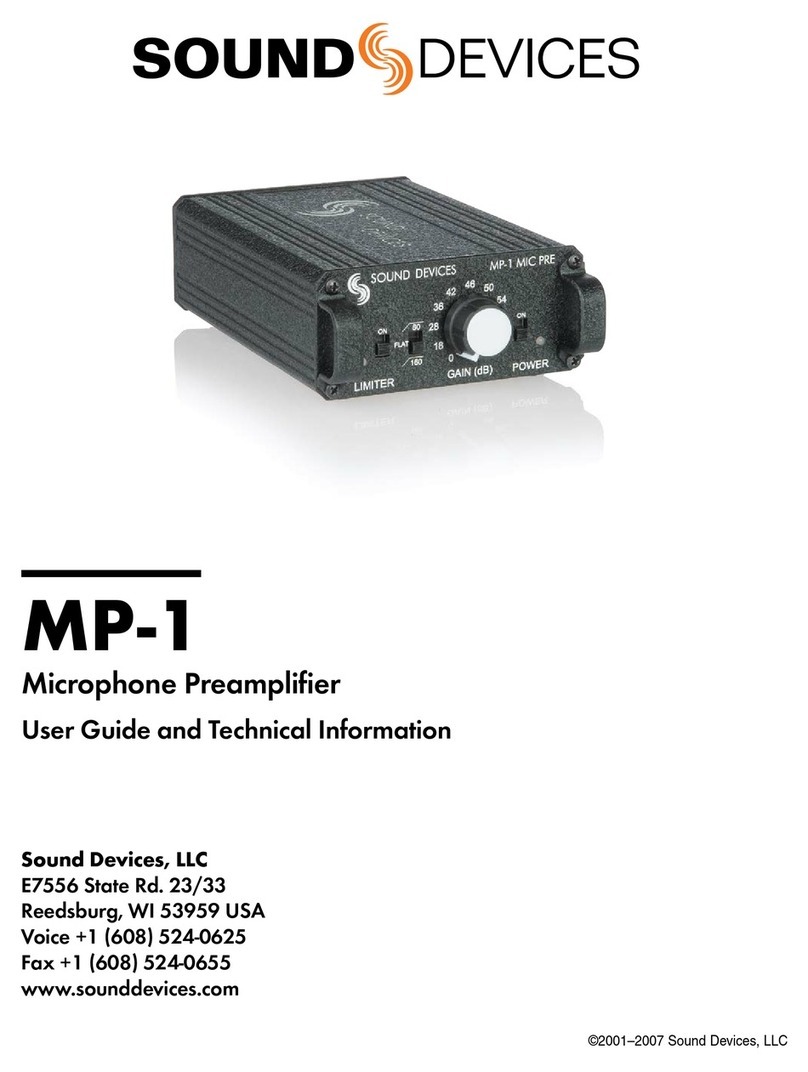
Sound Devices
Sound Devices MP-1 Manual
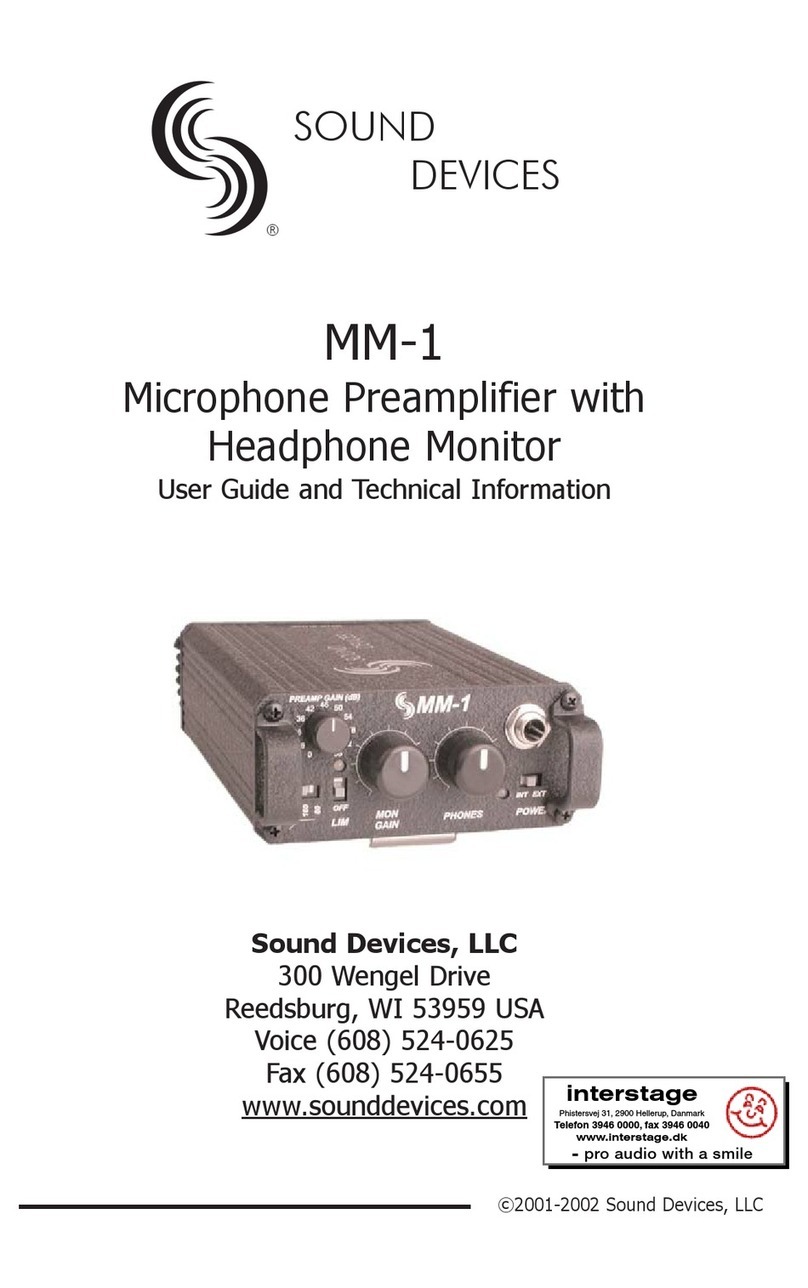
Sound Devices
Sound Devices MM-1 User manual
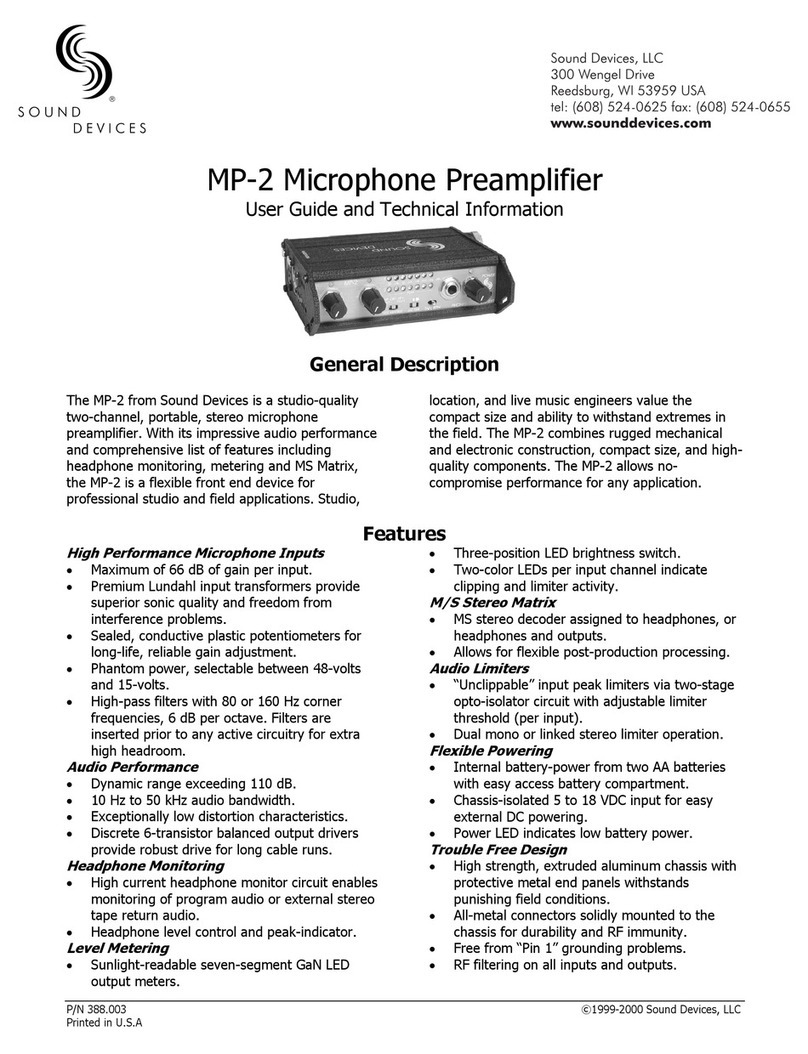
Sound Devices
Sound Devices MP-2 Manual
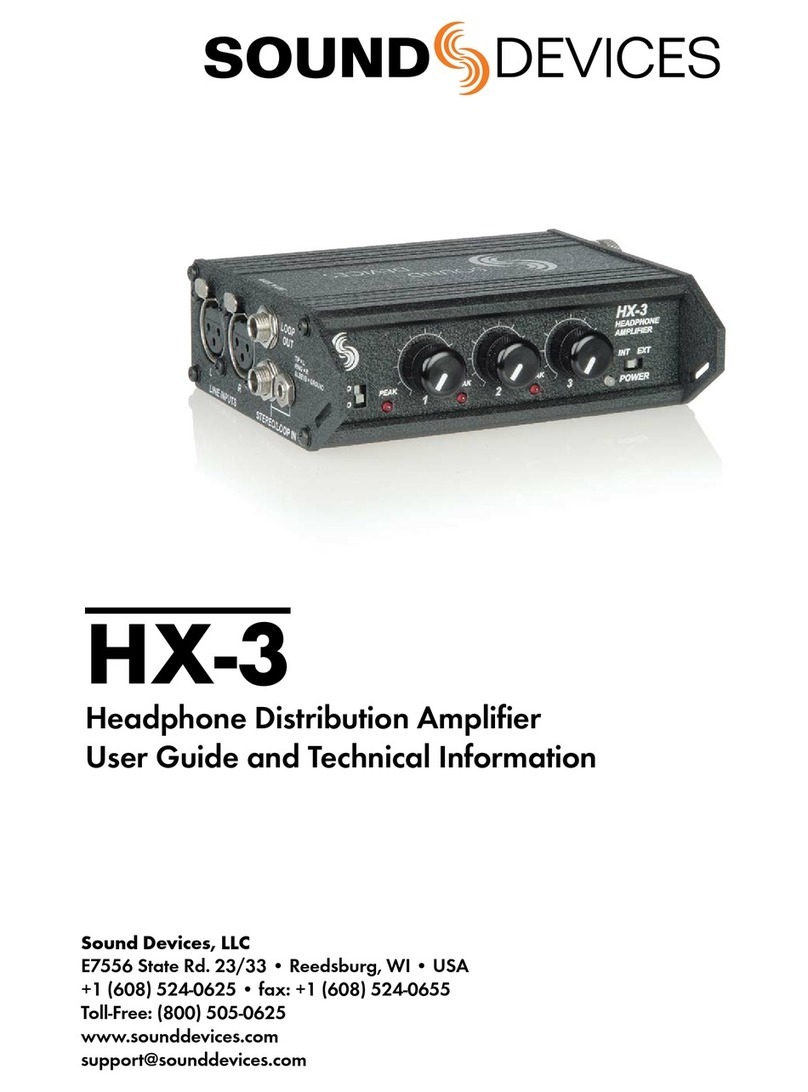
Sound Devices
Sound Devices HX-3 Manual
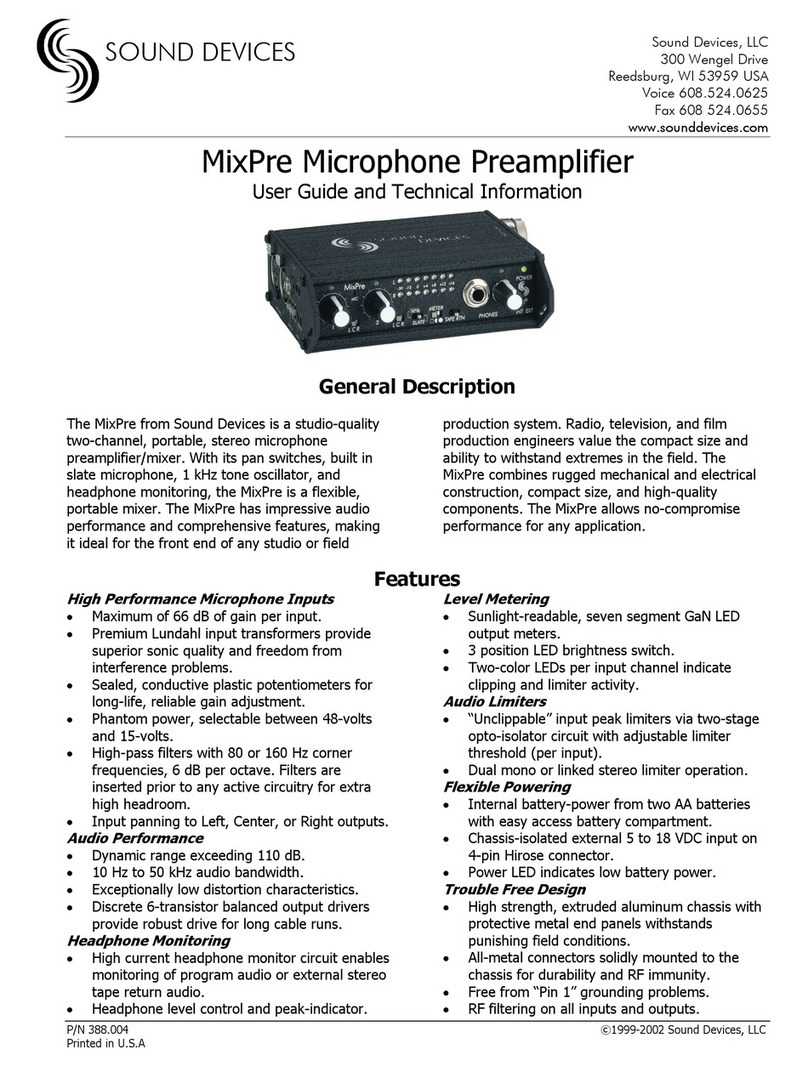
Sound Devices
Sound Devices MixPre User manual

Sound Devices
Sound Devices MM-1 Manual

Sound Devices
Sound Devices HX-3 User manual

Sound Devices
Sound Devices MixPre User manual

Sound Devices
Sound Devices MP-1 Manual

